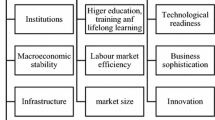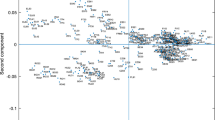Abstract
In the present work, we apply the canonical correlation analysis (CCA) to analyze the relationship between competitiveness and environmental sustainability, studying their degree of correlation and the impact of the environmental sustainability and competitiveness indicators in this relationship. We selected seven indicators from the environmental sustainability indicators of the Environmental Performance Index, and 12 competitiveness indicators from The Global Competitiveness Index. The CCA considers 117 countries common in both databases. The method is applied to study of the intracorrelations (correlations, between the same set of indicators) and the intercorrelations (correlations between the sustainability and competitiveness sets of indicators). It is shown that the intracorrelations of the environmental and competitiveness indicators are highly correlated, indicating that the choice of the indicators adequately describes sustainability and competitiveness, separately. For the study of the intercorrelation between the sustainability and the competitiveness sets of indicators, the CCA method reduced the complex multidimensional problem to a one-dimensional situation described by one relevant canonical function. This greatly simplified the interpretation of the interrelation between competitiveness and sustainability indicators allowing a proper analysis of the different degrees of correlation between these dimensions. A discussion on the degree of correlation between these indicators is presented. The results associating competitiveness and sustainability indicators through strong intercorrelation are an indication that the conclusion of the World Economic Forum analysis “the main and very important finding is that there is no necessary trade-off between being competitive and being sustainable. On the contrary, many countries at the top of the competitiveness rankings are also the best performers in many areas of sustainability,” may be related to the specific choice of indicators. The present study suggests that the strongly correlated indicators are good candidates to be part of an adequate set of composite sustainability and competitiveness indicators. Although in this work CCA is applied to study the environmental sustainability, the method can be applied to investigate other metrics in particular the intersection of social and competitiveness toward the achievement of sustainable development.

Similar content being viewed by others
References
Balkyte A, Tvaronaviciene M (2010) Perception of competitiveness in the context of sustainable development: facets of “sustainable competitiveness”. J Bus Econ Manag 11(2):341–365. doi:10.3846/jbem.2010.17
Barfield JP, Lam ETC (2003) Examination on the reliability of a racquetball skills test battery using univariate and multivariate models. (Measurement). Res Q Exerc Sport 74 (1):A-24(22)
Brandi HS, Daroda R, Olinto AC (2013) The use of Canberra metrics to aggregate metrics to sustainability. Clean Techn Environ Policy. doi:10.1007/s10098-013-0690-7
Correa NM, Yi-Ou L, Adali T, Calhoun VD (2008) Canonical Correlation Analysis for Feature-Based Fusion of Biomedical Imaging Modalities and Its Application to Detection of Associative Networks in Schizophrenia. Selected Topics in Signal Processing, IEEE Journal of 2(6):998–1007. doi:10.1109/jstsp.2008.2008265
Europe-2020 (2010) A Strategy for smart, sustainable and inclusive growth [online]. Communication from the Commissiononline, vol final. European Commission, COM(2010) Brussels
Field A (2005) Discovering Statistics Using SPSS, 2nd edn. SAGE Publications Ltd, London
Friman O, Cedefamn J, Lundberg P, Borga H, Knutsson H (2001) Detection of neural activity in functional MRI using canonical correlation analysis. Magn Reson Med 45(2):323–330. doi:10.1002/1522-2594(200102)45:2<323::AID-MRM1041>3.0.CO;2-#
Green PE, Carroll JD (1978a) Analyzing Multivariate Data. Holt, Rinehart & Winston, Hinsdale, Ill
Green PE, Carroll JD (1978b) Mathematical Tools for Applied Multivariate Analysis. Academic Press, New York
Hair JF, Anderson RE, Tatham RL, Black WC (2005) Análise Multivariada de Dados, 5a edn. Bookman, Porto Alegre
Hosany S, Ekinci Y, Uysal M (2006) Destination image and destination personality: An application of branding theories to tourism places. J Bus Res 59(5):638–642. doi:10.1016/j.jbusres.2006.01.001
Koh CE, Watson HJ (1998) Data management in executive information systems. Inf Manage 33(6):301–312. doi:10.1016/s0378-7206(98)00035-4
Kuylen AAA, Verhallen TMM (1981) The use of canonical analysis. Journal of Economic Psychology:20
Liu J, Drane W, Liu X, Wu T (2009) Examination of the relationships between environmental exposures to volatile organic compounds and biochemical liver tests: Application of canonical correlation analysis. Environ Res 109(2):193–199. doi:10.1016/j.envres.2008.11.002
Mazouz R, Assani AA, Rodríguez MA (2013) Application of redundancy analysis to hydroclimatology: A case study of spring heavy floods in southern Québec (Canada). Journal of Hydrology 496 (0):187-194. doi:http://dx.doi.org/10.1016/j.jhydrol.2013.05.035
Misaki M, Wallace GL, Dankner N, Martin A, Bandettini PA (2012) Characteristic cortical thickness patterns in adolescents with autism spectrum disorders: Interactions with age and intellectual ability revealed by canonical correlation analysis. NeuroImage 60 (3):1890-1901. doi:http://dx.doi.org/10.1016/j.neuroimage.2012.01.120
Mukherjee R, Sengupta D, Sikdar SK (2013) Parsimonious use of indicators for evaluating sustainability systems with multivariate statistical analyses. Clean Techn Environ Policy. doi:10.1007/s10098-013-0614-6
Nardo M, Saisana M, Tarantola ASS, Hoffman A, Giovannini E (2005) Handbook on Constructing Composite Indicators, Methodology and User Guide. OECD Statistics Working Paper:108
OECD (2010) Ministerial Report on the OECD Innovation Strategy: Fostering Innovation to Strengthen Growth and Address Global and Social Challenges - Key Findings.34
Rencher AC (2002) Methods of multivariate analysis, 2nd edn. John Wiley & Sons Inc, Canada
Sherry A, Henson RK (2005) Conducting and Interpreting Canonical Correlation Analysis in Personality Research: A User-Friendly Primer. J Pers Assess 84(1):37–48
Sikdar SK, Sengupta D, Harten P (2011) More on aggregating multiple indicators into a single index for sustainability analyses. Clean Techn Environ Policy 14(5):765–773
Sohn SY, Shin HW (2001) Canonical correlation analysis between road environmental conditions and traffic accident severity. Proceedings of the Eastern Asia Society for Transportation Studies, Vol 3, No 3
WCED (1987) Our Common Future: Report of the World Commission on Environment and Development (trans: Development WCoEa). UN, The United Nations - UN, Genebra
WEF (2012) The Global Competitiveness Report 2012-2013. 2012-2013 edn. World Economic Forum, Geneva
WEF (2013a) The Global Competitiveness Index 2013-2014 data platform. World Economic Forum
WEF (2013b) The Global Competitiveness Report 2013-2014. 2013-2014 edn. World Economic Forum, Geneva
Weiss EB (1993) Environmentally sustainable competitiveness: a comment. Yale Law Journal, vol 102
Wysokinska Z (2003) Competitiveness and its Relationships with Productivity and Sustainable Development. Fibres & Textiles in Eastern Europe 11(3):3
Environmental Performance Index (EPI) (2012) Yale University. http://www.epi.yale.edu/previous-work. Accessed 20 Aug 2013
Yuan YH, Sun QS, Ge HW (2014) Fractional-order embedding canonical correlation analysis and its applications to multi-view dimensionality reduction and recognition. Pattern Recognit 47(3):1411–1424. doi:10.1016/j.patcog.2013.09.009
Author information
Authors and Affiliations
Corresponding author
Appendices
Appendix 1: Key terms used in this work
The following key terms are used in this paper (Hair et al. 2005; Sherry and Henson 2005):
Canonical correlation (R c ) is the Person r relationship between the two variates in a given function and it ranges from 0 to 1. It measures the degree of the relations between the two variates. It squared value (\(R_{\text{C}}^{2}\)) represents the proportion of variance shared by the two variates from a given function and are also known as eigenvalues.
Canonical function relationship between two linear compositions (statistical canonical variables). Each canonical function is orthogonal to the other functions, meaning that they are statistically uncorrelated. Each canonical function has two variates (see Fig. 1), one for the set of dependent variables and other for the set of independent variables. The degree of the correlation is given by the canonical correlation coefficient (R c). The number of function for a given canonical solution is limited to the number of the variables of the smaller set.
Standardized canonical function coefficients (Coef) are the standardized canonical coefficients (weights) used in the linear equations to combine the observed variables (predictors, independent variables) and criterion variables (dependent variables) into two respective variates. The weights are applied to the observed scores in z-scores form (standardized) to yield the structure coefficients which correlate the variables with variates.
Structure coefficients or canonical loadings (r s) measure of bivariate correlation between an observed variable and a variate. It is the Pearson r between an observed variable (indicator in this study) a variate from a given canonical function. It may range from −1 to +1. The square value of this parameter (\(r_{\text{s}}^{2}\)) indicates the proportion of variance that an observed variable linearly shares with the variates.
Canonical cross-loadings (Λ) correlation of each dependent or independent observed variable with the opposite canonical statistical variable.
Redundancy index (\(R_{\text{d}}\)) is the amount of variance of a statistical variable (variate) explained by the other statistical variable in a given canonical function. It can be computed for the dependent statistical variables as well as for the independent statistical variable from a given canonical function. A redundancy index for the dependent variables represents the amount of variance from dependent variables explained by the independent statistical variable.
Appendix 2: Analysis of redundancy and cross loading computation
The analysis of redundancy evaluates practical significance and the amount of variance of one canonical variate (dependent or independent) by the other canonical variate. The canonical cross loading determines the relative contribution of each original variable in the canonical relationship. The cross loading method provides a direct measure of the variables relationship, since it involves directly correlating each variable with the other variates, and vice versa (Hair et al. 2005). In fact, for the above reasons cross-loadings is the most recommended among the three methods used to for interpret canonical variates: (a) standardized coefficients (canonical weights), (b) canonical loadings (structure correlations), and (c) canonical cross-loadings.
The redundancy index can be expressed as (Hair et al. 2005; Rencher 2002)
where \(R_{\text{dxn}}\) = redundancy index of independent variables of the function n, \(R_{\text{dyn}}\) = redundancy index of dependent variables of the function n, \(R_{\text{cn}}\) = canonical correlation coefficient of the canonical function n, \(\bar{r}_{\text{sxn}}^{2}\) = mean of squared loadings of independent variables of the canonical function n, \(\bar{r}_{\text{syn}}^{2}\) = mean of squared loadings of dependent variables of the canonical function n.
The cross-loadings can be computed as (Hair et al. 2005):
where \(\frac{{\varLambda_{\text{xni}} }}{y}\) = cross loading of independent variable i in the variate X to the variate Y of function n, \(\frac{{\varLambda_{\text{ynj}} }}{x}\) = cross loading of independent variable j in the variate Y to the variate X of function n, \(R_{\text{cn}}\) = canonical correlation coefficient of the canonical function n, \(r_{\text{sxni}}\) = loading of the independent variable i in the variate X of function n, \(r_{\text{synj}}\) = loading of the independent variable j in the variate Y of function n.
Rights and permissions
About this article
Cite this article
dos Santos, S.F., Brandi, H.S. A canonical correlation analysis of the relationship between sustainability and competitiveness. Clean Techn Environ Policy 16, 1735–1746 (2014). https://doi.org/10.1007/s10098-014-0755-2
Received:
Accepted:
Published:
Issue Date:
DOI: https://doi.org/10.1007/s10098-014-0755-2




